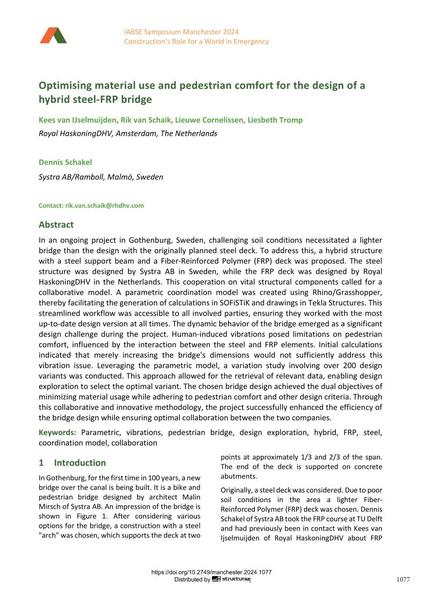Optimising material use and pedestrian comfort for the design of a hybrid steel-FRP bridge

|
|
|||||||||||
Détails bibliographiques
| Auteur(s): |
Kees Van Ijselmuijden
(Royal HaskoningDHV, Amsterdam, The Netherlands)
Rik van Schaik (Royal HaskoningDHV, Amsterdam, The Netherlands) Lieuwe Cornelissen (Royal HaskoningDHV, Amsterdam, The Netherlands) Liesbeth Tromp (Royal HaskoningDHV, Amsterdam, The Netherlands) Dennis Schakel (Systra AB/Ramboll, Malmö, Sweden) |
||||
|---|---|---|---|---|---|
| Médium: | papier de conférence | ||||
| Langue(s): | anglais | ||||
| Conférence: | IABSE Symposium: Construction’s Role for a World in Emergency, Manchester, United Kingdom, 10-14 April 2024 | ||||
| Publié dans: | IABSE Symposium Manchester 2024 | ||||
|
|||||
| Page(s): | 1077-1082 | ||||
| Nombre total de pages (du PDF): | 6 | ||||
| DOI: | 10.2749/manchester.2024.1077 | ||||
| Abstrait: |
In an ongoing project in Gothenburg, Sweden, challenging soil conditions necessitated a lighter bridge than the design with the originally planned steel deck. To address this, a hybrid structure with a steel support beam and a Fiber-Reinforced Polymer (FRP) deck was proposed. The steel structure was designed by Systra AB in Sweden, while the FRP deck was designed by Royal HaskoningDHV in the Netherlands. This cooperation on vital structural components called for a collaborative model. A parametric coordination model was created using Rhino/Grasshopper, thereby facilitating the generation of calculations in SOFiSTiK and drawings in Tekla Structures. This streamlined workflow was accessible to all involved parties, ensuring they worked with the most up-to-date design version at all times. The dynamic behavior of the bridge emerged as a significant design challenge during the project. Human-induced vibrations posed limitations on pedestrian comfort, influenced by the interaction between the steel and FRP elements. Initial calculations indicated that merely increasing the bridge's dimensions would not sufficiently address this vibration issue. Leveraging the parametric model, a variation study involving over 200 design variants was conducted. This approach allowed for the retrieval of relevant data, enabling design exploration to select the optimal variant. The chosen bridge design achieved the dual objectives of minimizing material usage while adhering to pedestrian comfort and other design criteria. Through this collaborative and innovative methodology, the project successfully enhanced the efficiency of the bridge design while ensuring optimal collaboration between the two companies. |
||||
| Mots-clé: |
acier passerelle piétonnne
|
||||


